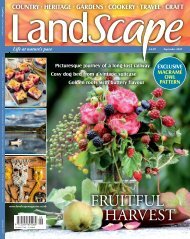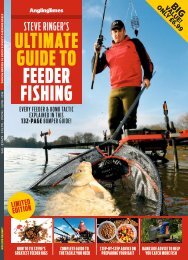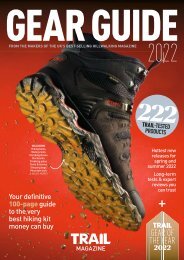Mother&Baby Mar20
You also want an ePaper? Increase the reach of your titles
YUMPU automatically turns print PDFs into web optimized ePapers that Google loves.
MARCH 2020 THE No.1 PREGNANCY, BABY AND TODDLER MAGAZINE<br />
WWW.MOTHERANDBABY.CO.UK<br />
www.motherandbaby.co.uk<br />
THE NO.1 PREGNANCY, BABY AND TODDLER MAGAZINE<br />
Look who’s<br />
talking...<br />
Fun ideas to help you<br />
communicate with your<br />
baby from day one!<br />
WEANING WINNERS<br />
PERFECT FIRST FOODS<br />
YOUR TOT WILL LOVE<br />
9<br />
EASY WAYS TO<br />
RIDE OUT YOUR<br />
CONTRACTIONS<br />
SNUGGLE UP!<br />
BABYWEARING<br />
MADE SIMPLE<br />
WE TRY, YOU BUY<br />
BEDSIDE CRIBS<br />
Pregnancy<br />
Reviews<br />
TRIED<br />
AND<br />
TRUSTED<br />
Advice<br />
www.motherandbaby.co.uk<br />
win!<br />
prizes<br />
worth<br />
£2,504!<br />
£4.50 MARCH 2020<br />
22 JAN TO 18 FEB<br />
Shopping
<strong>Baby</strong>&Toddler<br />
Love is<br />
all around us<br />
You are your baby’s first love – here’s how to build on your bond<br />
and support his ability to forge connections as he grows…<br />
tip<br />
A recent study found that<br />
men who take their babies<br />
out of the house in a sling<br />
develop a stronger relationship<br />
with them. So grab a carrier<br />
and make 15-minute walks<br />
a regular date – it works<br />
for mums too!<br />
WORDS HATTIE GARLICK PHOTOGRAPHY SHUTTERSTOCK, ADOBE STOCK<br />
At this time of year we’re<br />
constantly being bombarded<br />
by hearts and flowers and mad,<br />
overblown images of romance<br />
that most of us fall well short of<br />
in our usual day-to-day lives.<br />
But there is one rush you feel that means<br />
more than a million Valentine’s Day cards<br />
and a houseful of flowers – that crazy little<br />
thing called love you have with your baby.<br />
Because, right now, you’re the centre of his<br />
universe, and the very first person he’ll have<br />
a relationship with. You are his first love.<br />
And it’s from the bond he makes with<br />
you that he’ll learn how to handle all of his<br />
future connections as he grows. Yes, all of<br />
his future friends, playmates, even romantic<br />
relationships, will stem from your special<br />
bond. Research suggests that the quality of<br />
the relationships in your child’s early years<br />
will affect almost every aspect of his later<br />
development, from his self-confidence to<br />
his motivation to learn and his ability<br />
to forge friendships. By understanding<br />
how your baby bonds with you, you<br />
can support these developing skills.<br />
Just like any relationship, the<br />
moment true love strikes happens at<br />
different times for different people:<br />
some mums feel a strong bond growing<br />
with their bump, some find it’s love at first<br />
sight, while for some it can take days or<br />
months for it to form and strengthen. But<br />
whichever way it happens, it does happen.<br />
Attachment is based on familiarity so, simply<br />
by being with your baby, your bond grows.<br />
From your baby’s point of view, though,<br />
this connection happens from the get-go.<br />
‘From the moment of birth, if not before,<br />
babies appear to have innate mechanisms that<br />
prompt them to learn about who looks after<br />
them, and who can teach them about social<br />
MEET THE<br />
EXPERT<br />
Professor Pasco<br />
Fearon is a professor<br />
of developmental<br />
psychopathology<br />
and a clinical<br />
psychologist at<br />
University College<br />
London<br />
tip<br />
When you’re soothing<br />
your baby, make your first<br />
step to slow everything<br />
down. What’s important is<br />
that you’re connecting with<br />
your baby, rather than<br />
rushing to find an<br />
instant fix.<br />
interaction,’ explains clinical psychologist<br />
Professor Pasco Fearon. Skin-to-skin contact<br />
with your newborn releases oxytocin, a<br />
hormone that promotes bonding. And<br />
experiments show that babies as young as<br />
12 hours old show a clear preference for<br />
watching their mum’s face over those of<br />
strangers, and for her voice. In fact, babies<br />
in the womb have been shown to turn their<br />
heads in response to voices outside from just<br />
24 weeks into a pregnancy, so your baby<br />
will have grown used to yours well before<br />
he makes his appearance.<br />
Your bond grows as you spend time<br />
together. ‘The attachment process is very<br />
much a two-way street, involving you<br />
as much as your baby,’ explains Pasco.<br />
And that’s because all those day-today<br />
interactions you have with your<br />
little one are the building blocks of<br />
his early brain development.<br />
When your baby<br />
babbles, you<br />
respond<br />
62 | March 2020 | motherandbaby.co.uk motherandbaby.co.uk | March 2020 | 63
WORDS EMILY THORPE PHOTOGRAPHY ISTOCK, GETTY IMAGES<br />
Meaningful<br />
ME-TIME<br />
In the midst of manic motherhood, every mum needs<br />
her Unicorn Space. Confused? Read on…<br />
It’s 8pm and the house is finally quiet<br />
after a day of chaos. Your baby is<br />
asleep after some resistance, and the<br />
remnants of dinner have been cleared<br />
away. A pocket of glorious free<br />
time stretches out in front of you.<br />
The question is – what exactly do you do<br />
with this rare opportunity?<br />
For many of us mums, it’s time to try to<br />
make a dent in the never-ending to-do list<br />
of jobs that need to be done. It hardly even<br />
crosses our minds that we could use this<br />
time for... ourselves!<br />
‘Many new mums willingly take on this<br />
new role without fully recognising the endless<br />
emotional, mental, and physical effort<br />
parenthood requires,’ says organisational<br />
specialist and author Eve Rodsky. ‘Before<br />
we can catch our breath in between sterilising<br />
bottles, doing dishes, folding laundry,<br />
restocking the nursery, running to the<br />
supermarket, picking up prescriptions,<br />
preparing meals, tidying up, and attending<br />
to our little ones, we discover that we have<br />
no time left for ourselves.’<br />
And it’s not just this eternal busyness that<br />
may prevent you from spending any time<br />
on yourself – we’re all-too familiar with<br />
the looming presence of mum-guilt, too.<br />
‘Recent research exploring mother’s guilt<br />
found that mothers feel far guiltier than<br />
fathers,’ says Eve. ‘So many of us have bought<br />
into the cultural messaging that a good<br />
mother spends the bulk of her available time<br />
in service to the family, or risk suffering<br />
disapproval from her community, peers and<br />
even her partner for spending her hours<br />
differently. But it’s time that we re-frame<br />
what it means to be a “good” mum as a<br />
woman who spends her time in service to<br />
her family and to herself.’<br />
Time where you’re not being mum may feel<br />
like a rare experience you’ve only occasionally<br />
MEET THE<br />
EXPERT<br />
Eve Rodsky is an<br />
organisational<br />
specialist, author of<br />
Fair Play (£16.99,<br />
Quercus), and<br />
a mum of three<br />
dabbled in – but it’s an important one. Eve<br />
has dubbed this time as Unicorn Space. That<br />
might make it sound magical, whimsical, and<br />
even slightly unobtainable but, don’t worry,<br />
it’s actually pretty straightforward.<br />
‘Unicorn Space allows you to reclaim or<br />
discover the interests or talents that make you<br />
uniquely you, driving you to be the fullest<br />
expression of yourself,’ she explains. ‘It boosts<br />
your individual happiness and strengthens<br />
partnerships. The necessity for Unicorn Space<br />
emerged from my interviews with hundreds<br />
of women around the world who shared a<br />
longing for their pre-parent self, or for a new<br />
version of themselves that they described<br />
as “more alive”, “fuller”, “expressive”<br />
and “purposeful”.’<br />
Unicorn Space is not just another version<br />
of self-care, either. While that might include<br />
you getting a massage, or cosying up with<br />
a good book, Unicorn Space is a form of<br />
meaningful me-time which is connected to a<br />
larger goal that can also be shared with others<br />
in some way. While both are important, these<br />
should be treated as very separate things.<br />
If you’re thinking to yourself, ‘Sure,<br />
Unicorn Space sounds great! But how on<br />
Life&Kids<br />
Win!<br />
If you fancy getting your hands<br />
on Eve's book Fair Play (£16.99,<br />
Quercus), we’ve got five copies<br />
to give away. Visit winit.mother<br />
andbaby.co.uk by 18 February<br />
2020 – see website for terms<br />
and conditions.<br />
84 | March 2020 | motherandbaby.co.uk<br />
motherandbaby.co.uk | March 2020 | 85
FEATURE NAME<br />
Pack Mane ‘N Tail<br />
Detangler (£7.99, superdrug.<br />
com) in your hospital bag.<br />
Giving birth can lead to extreme<br />
bedhead hair, but this will take<br />
care of the most stubborn<br />
of knots!<br />
During pregnancy you expect<br />
to look and feel different –<br />
after all, there’s a whole lot<br />
of impressive stuff going on<br />
inside you to help grow a<br />
baby! But changes to your<br />
hair can be a lot more unpredictable – you<br />
may be blessed with the most voluminous,<br />
shiny hair you’ve ever had, or experience<br />
oiliness or a change in texture – all of which<br />
are completely normal. ‘Pregnancy hair varies<br />
from woman to woman,’ says trichologist<br />
Anabel Kingsley. ‘Some pregnant ladies<br />
experience lots of changes to their hair, while<br />
others don’t notice anything at all. Hair can<br />
even react differently in different pregnancies.<br />
Just like pregnancy skin, sometimes it improves,<br />
sometimes it doesn’t. Rest assured, though,<br />
your hair will be back to your hair – possibly<br />
with added perks – around a year after having<br />
your baby.’ So, stay positive and remember:<br />
there are ways of handling the changes so you<br />
can experience lots more good hair days!<br />
THE THICK OF IT<br />
‘The most common hair change reported by<br />
pregnant ladies is fuller locks,’ says Anabel.<br />
‘But you’re not magically growing more hair<br />
– this thickness happens because you’re losing<br />
less hairs daily than you would normally. The<br />
average person usually loses around 100 hairs<br />
a day as part of the natural hair cycle. But<br />
when you’re pregnant, increased oestrogen<br />
levels, which soar during the first trimester<br />
and continue into the other two, cause your<br />
hair to sit in the growth phase of the hair<br />
cycle for longer, so hair shedding is delayed.<br />
This means you only lose around 20 hairs a<br />
day.’ It’s this strand build-up that gives you<br />
the appearance of thicker hair.<br />
‘Some women are convinced their hair is<br />
growing longer, too,’ says Anabel. ‘But strands<br />
can only grow half an inch a month. So,<br />
this is just a perceived concept thanks<br />
to the thickness.’ This thickness<br />
makes any hair style look<br />
amazing, but you might need to<br />
take smaller sections when<br />
curling or straightening to<br />
get good results. And, when<br />
pinning your hair up,<br />
double up and use grips<br />
lapped over each other<br />
across the grooves at each<br />
end, for added support.<br />
THINLY VEILED<br />
At the other end of the<br />
strand-scale, you may<br />
experience hair loss – known as<br />
shedding. While this is most likely<br />
to occur post-baby, it can also strike<br />
Colour<br />
crisis?<br />
Deciding whether<br />
to colour your hair<br />
when pregnant is a<br />
personal choice.<br />
Your scalp can be<br />
more sensitive,<br />
so an adverse<br />
reaction could<br />
happen even if<br />
you’ve had<br />
treatments for<br />
years – do a patch<br />
test first.<br />
Whatever you<br />
decide, once<br />
you’ve had your<br />
baby a trip to the<br />
salon can help<br />
your hair’s<br />
appearance. ‘Visit<br />
a good colourist<br />
who won’t<br />
over-process your<br />
post-partum hair,’<br />
advises Anabel.<br />
‘Also work to<br />
reduce the<br />
contrast between<br />
your scalp and hair<br />
colours in order to<br />
make hair appear<br />
fuller when that<br />
shedding starts.’<br />
Little<br />
fluffers<br />
During the fourth trimester, as all those<br />
old hairs start shedding on mass, new hairs<br />
must grow. Which means baby hairs are pretty<br />
much inevitable. ‘It’s actually when your hair<br />
starts to grow back that you notice how much<br />
you’ve lost,’ says Anabel. ‘You do lose hairs from<br />
your crown, but it’s most noticeable around your<br />
temples and above your ears, as you see these<br />
areas daily. Ride these wispy bits out – your<br />
baby is the reason why they are there,<br />
it’s out of your control, and every<br />
baby hair is one hair closer to<br />
getting your former<br />
locks back.’<br />
Bump&Birth<br />
during pregnancy. ‘Morning sickness can<br />
contribute to shedding,’ explains Anabel.<br />
‘Your hair needs nutrients to grow, but the<br />
essentials go to your baby first. Gestational<br />
diabetes, coming off the contraceptive pill, and<br />
iron deficiency can also encourage shedding.<br />
Stress plays a part, too, especially when the<br />
shedding happens during the first trimester,<br />
or very soon into the second. The loss is a<br />
reflection of what happened three months<br />
earlier – tying into the hair cycle – so if you<br />
had a tough time getting pregnant or in the<br />
early days, your hair can react.’<br />
All these factors, and more, can contribute<br />
to hair loss once you have your baby. ‘Postpartum<br />
hair loss is reported to affect 50 per<br />
cent of women,’ says Anabel. ‘However,<br />
experts believe the figure is likely to be much<br />
higher, given what women go through to get<br />
their babies safely into the world. Then you<br />
need to consider the sudden dip of oestrogen,<br />
which happens after birth and takes effect on<br />
your hair around three months afterwards –<br />
or later if you’re breastfeeding.’ It kick-starts<br />
your hair cycle into a more typical time frame,<br />
so the shedding begins and it’s time to lose<br />
the hairs you’ve been building up over the<br />
previous nine months.<br />
It’s frustrating, but it isn’t forever. ‘About<br />
six months on, the shedding will go back to a<br />
typical hair growth and loss cycle,’ reassures<br />
Anabel. ‘Once your baby is here, or after you<br />
finish breastfeeding, it’s time to support new<br />
hairs as the increased shedding goes on.’ This<br />
means eating the right foods packed with iron<br />
– beetroot, spinach and steak are great – and<br />
keeping to regular meals as much as possible.<br />
Managing this stress, with the help of family<br />
and friends, will allow your hair to grow back<br />
stronger than ever – just like you.<br />
And while you’re experiencing shedding,<br />
you can make your hair feel thicker all over.<br />
You gotta love a mum bun – try plaiting<br />
your hair before you swirl it up into<br />
the bun, pin it in place and then<br />
pull at the sides of the plait to<br />
add volume. Or curl your hair<br />
in chunky sections – thinner<br />
hair bends so much quicker<br />
– to add width. It’s also<br />
worth using Lee Stafford<br />
Hair Growth Scalp<br />
Scrub (£8.99, boots.<br />
com) once or twice a<br />
week, to help things along.<br />
SHINY HAPPY HAIR<br />
Another hair wild card is<br />
how shiny your hair will<br />
go during pregnancy. ‘Your<br />
scalp produces less oils when<br />
you’re pregnant, which means<br />
22 | March 2020 | motherandbaby.co.uk motherandbaby.co.uk | March 2020 | 23
The food<br />
of love<br />
Get your little helpers on board this Valentine’s Day!<br />
SUITABLE<br />
FROM 12<br />
MONTHS<br />
A new way<br />
to sneak in those<br />
veggies! Plus, the<br />
beetroot will help to<br />
keep this cake lovely<br />
and moist.<br />
Beetroot<br />
chocolate cake<br />
Prep: 10 minutes<br />
Cook: 20 minutes<br />
Makes: 12 portions<br />
Directions<br />
1 Preheat the oven<br />
to 160˚C/300˚F/<br />
gas mark 2.<br />
2 Line a small baking<br />
tray or roasting tin with<br />
non-stick paper.<br />
3 Measure all of the<br />
ingredients into a bowl.<br />
Whisk together until<br />
light and fluffy.<br />
4 Spoon into the tin<br />
and level the top.<br />
5 Bake for 20<br />
minutes,<br />
until well<br />
risen<br />
and firm<br />
in the<br />
centre.<br />
SUITABLE<br />
FROM 12<br />
MONTHS<br />
Ingredients<br />
● 3 eggs<br />
● 70g light<br />
brown sugar<br />
● 125g self-raising<br />
flour<br />
● 1 tsp baking<br />
powder<br />
● 25g cocoa<br />
powder<br />
● 100g butter,<br />
softened<br />
● 50g maple syrup<br />
● 100g beetroot,<br />
cooked and grated<br />
● 80g melted<br />
chocolate<br />
MEET THE<br />
EXPERT<br />
Annabel Karmel<br />
is a children’s<br />
food expert,<br />
bestselling author,<br />
and a mum of three<br />
Plum & almond heart cake<br />
Prep: 20 minutes<br />
Cook: 1 hour 10 minutes<br />
Makes: 8 portions<br />
Directions<br />
1 Preheat the oven to 160˚C/<br />
300˚F/gas mark 2. Grease and line<br />
the base of a heart-shaped baking<br />
tin (roughly 20cm).<br />
2 Measure the butter, sugar, eggs,<br />
flour, ground almonds and almond<br />
extract into a bowl. Whisk using an<br />
electric hand whisk. Dice 2 of the plums<br />
and stir into the mixture.<br />
3 Spoon into the tin and level the<br />
surface. Slice the remaining plums<br />
and arrange on top. Sprinkle with<br />
flaked almonds.<br />
4 Bake for 1 hour 10 minutes until well<br />
risen and firm to the touch in the middle.<br />
Leave to cool slightly.<br />
5 Meanwhile, heat the jam in a pan<br />
over a low heat until loosened, to create<br />
a glaze. Brush the glaze over the top<br />
of the cake to serve.<br />
This recipe<br />
requires lots of measuring,<br />
mixing and whisking<br />
assistance – the perfect<br />
tasks for those new to<br />
the kitchen.<br />
● 175g butter,<br />
softened<br />
● 150g caster<br />
sugar<br />
● 3 large eggs<br />
● 150g self-raising<br />
flour<br />
● 75g ground<br />
Ingredients<br />
almonds<br />
● 1½ tsp almond<br />
extract<br />
● 4 large plums<br />
● 25g flaked<br />
almonds<br />
● 1 tbsp raspberry<br />
or plum jam<br />
Rice Krispie<br />
hearts<br />
Prep: 10 minutes<br />
(excluding chilling time)<br />
Cook: 5 minutes<br />
Makes: 6-8 hearts<br />
Directions<br />
1 Measure the syrup and butter into a<br />
pan. Heat until melted, stirring. Add the<br />
white chocolate and stir until runny. Add<br />
the remaining ingredients and mix well.<br />
2 Spoon into 6 to 8 small heart-shaped<br />
moulds. Chill for 2 hours, until firm.<br />
3 Loosen the edges and turn out the<br />
Rice Krispie hearts. Chill in the fridge<br />
for a further 2 hours.<br />
● 100g golden syrup<br />
● 100g butter<br />
● 100g white chocolate<br />
● 50g Rice Krispies<br />
Ingredients<br />
● 75g porridge oats<br />
● 50g dried cranberries,<br />
chopped<br />
● 40g pecans,<br />
chopped<br />
SUITABLE<br />
FROM 12<br />
MONTHS<br />
These little<br />
bites of heartshaped<br />
loveliness<br />
say it all!<br />
FUN WITH<br />
FOOD<br />
For more<br />
family meal<br />
inspiration and<br />
healthy-eating<br />
guides, head to<br />
motherandbaby.<br />
co.uk/food<br />
96 | March 2020 | motherandbaby.co.uk<br />
motherandbaby.co.uk | March 2020 | 97
Babies can’t do anything for themselves when<br />
they’re born. They need you to feed them,<br />
cuddle them, help them to sleep… ‘So, it’s no<br />
surprise that they have a strong motivation to<br />
communicate what they want,’ says Annie.<br />
‘They need it to survive!’ Right from the<br />
get-go, your baby’s cries are trying to tell you<br />
something. ‘In the first few weeks, the noises<br />
your baby makes when she cries will probably<br />
just sound piercing and strained,’ says Annie.<br />
‘She’s learning to use her voice and you’re<br />
learning to interpret it. But as the weeks go by,<br />
if you listen very carefully, you’ll gradually<br />
start to hear that there are differences in the<br />
cry: your baby is using a variety of noises to<br />
indicate what she wants.’<br />
Newborns always have a hearing test –<br />
either carried out before you leave hospital<br />
or done by a health professional in the first<br />
few weeks of your youngster’s life. ‘This is<br />
really important because, if babies can’t hear<br />
sounds, they can’t copy them,’ says Annie.<br />
Copying is one of the skills babies use to learn<br />
language. And it’s not just sounds that babies<br />
imitate – it’s also the way our mouth, face and<br />
eyes move when we talk. As time progresses,<br />
listen out for your baby starting to make a few<br />
gentle open vowel sounds, such as ‘ooh’ and<br />
‘ah’. ‘It doesn’t take much strength in the<br />
tongue, jaw or lips to make these sounds, so<br />
they’re the ones that come first,’ says Annie.<br />
‘By five to six months this cooing turns into<br />
a babbling sound that is more rhythmic.<br />
This shows that she’s enjoying the sound<br />
of her own voice, which is important for<br />
developing language skills, and she’s trying<br />
out the sounds that she hears.’ Here’s what<br />
you can do to help her…<br />
Have<br />
daily sayings<br />
When you have a baby, there are some<br />
things you do every day: you change her nappy, you<br />
feed her, you put her in her cot. ‘Each daily routine is a<br />
rich opportunity for communication,’ says Annie. ‘If you use<br />
the same words to describe each experience, each time,<br />
your baby will become attuned to those words. So, say,<br />
“nappy time!” every time you change her. And<br />
reinforce the word “nappy” by tapping her nappy<br />
when you say it. Keep it simple: you just want<br />
two to three words for each action, such as<br />
“Bedtime!”, “Let’s have milk!” and<br />
“Let’s go out!”’<br />
LEARNING<br />
TO TALK<br />
Special<br />
0-6 months<br />
Hold<br />
her close<br />
Your baby can’t see very far when she’s<br />
tiny, but she’s able to focus on your face when<br />
you’re holding her in your arms. In this position<br />
she’s able to see, feel and smell you. Spend time<br />
alone with her, looking at her and chatting. It’s<br />
a wonderful opportunity for your baby to<br />
watch you and focus on the sounds<br />
you’re making.<br />
Think<br />
tummy talk<br />
time<br />
Your baby may not be a fan of tummy time, but<br />
there’s a simple way to make her happier on the floor<br />
and to build her language skills – get down there with<br />
her! ‘If you lie on your tummy, facing your baby, it<br />
motivates her to raise her head and look at you,’ says<br />
Annie. ‘This builds her muscles, which she needs<br />
for eating as well as for rolling, crawling<br />
and walking, and it’s a great opportunity<br />
Use a<br />
parent-facing<br />
stroller<br />
Babies love looking at faces – and of all faces, your face<br />
is the one your baby loves best. ‘When you’re out and<br />
about, have your baby facing you,’ says Annie. ‘She can hear<br />
you and watch your mouth as you talk. Plus, you will be able to<br />
see what she’s aware of. If she jumps when a car horn beeps,<br />
you can respond to that and say, “That’s a car horn. Beep<br />
beep!” That gives words to her experience, which is an<br />
important part of helping her to understand the<br />
world. She needs to understand before she<br />
can communicate with gestures or words.’<br />
Make<br />
up lullabies<br />
‘Singing any lullaby or nursery rhyme is a<br />
wonderful way to build up your baby’s understanding<br />
of words and language,’ says Annie. ‘But if you can adapt<br />
existing lullabies, or make up your own, you can add in words<br />
that your baby hears a lot anyway.’ These familiar words act<br />
as an anchor – helping to secure your baby’s understanding<br />
of the sounds you’re making. For instance:<br />
Woof, woof, woof, says our dog Jack,<br />
Chasing leaves around the track.<br />
He just likes to bark and run<br />
And give a lick to everyone…<br />
Woof, woof, woof, says our dog Jack,<br />
Chasing leaves around the track.<br />
‘I talk non-stop to my<br />
two – about everything!<br />
What clothes I’m putting on<br />
them; what we’re doing; what I’m<br />
writing on the shopping list. My<br />
oldest has a wide vocabulary and my<br />
youngest is already babbling away!’<br />
Samantha Shea, 34, from<br />
Bedford, is mum to Artemis,<br />
four-and-a-half months,<br />
and Olivia, four<br />
48 | March 2020 | motherandbaby.co.uk<br />
to talk face-to-face.’<br />
motherandbaby.co.uk | March 2020 | 49

















